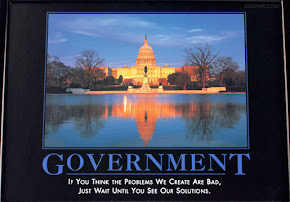Thursday, August 9, 2012
Economic Lessons from American History by John Steele Gordon
John Gordon gives great insight into the historical implications of what our government is doing to destroy our standing in the world.
Excerpt: Today we live in a world far beyond the imagination of those who were alive in 1607. The poorest family in America today enjoys a standard of living that would have been considered opulent 400 years ago. And for most of this time it was the United States that was leading the world into the future, politically and economically.
This astonishing economic transformation provides rich lessons in examples of what to do and not do. Let me suggest five.
1. Governments Are Terrible Investors
2. Politicians Have Self-Interest Too
3. Immigration is a Good Thing
4. Good Ideas Spread, Bad Ones Don’t ( I selected this snippet as a sample of the history surrounding one of my favorite causes, tort reform.)
Thomas Jefferson the first person in history to advocate a system of decimal coinage, and the United States the first country to adopt one. This was a very good idea, and, as good ideas always do, it quickly spread. Today every country on earth has a decimal currency system.
But if Jefferson’s decimal coinage concept was a good idea that quickly spread around the world, another idea that developed here at that time was lousy: the so-called American Rule, whereby each side in a civil legal case pays its own court costs regardless of outcome. This was different from the English system where the loser has to pay the court costs of both sides.
The American Rule came about as what might be called a deadbeat’s relief act. The Treaty of Paris (which ended the American Revolution) stipulated that British creditors could sue in American courts in order to collect debts owed them by people who were now American citizens. To make it less likely that they would do so, state legislatures passed the American Rule. With the British merchant stuck paying his own court costs, he had little incentive to go to court unless the debt was considerable.
The American Rule was a relatively minor anomaly in our legal system until the mid-20th century. But since then, as lawyers’ ethics changed and they became much more active in seeking cases, the American Rule has proved an engine of litigation. For every malpractice case filed in 1960, for instance, 300 are filed today. In practice, the American Rule has become an open invitation, frequently accepted, to legal extortion: “Pay us $25,000 to go away or spend $250,000 to defend yourself successfully in court. Your choice.”
Trial lawyers defend the American Rule fiercely. They also make more political contributions, mostly to Democrats, than any other set of donors except labor unions. One of their main arguments for the status quo is that the vast number of lawsuits from which they profit so handsomely force doctors, manufacturers, and others to be more careful than they otherwise might be. Private lawsuits, these lawyers maintain, police the public marketplace by going after bad guys so the government doesn’t have to—a curious assertion, given that policing the marketplace has long been considered a quintessential function of government.
The reason for this is that when policing has been in private hands, self-interest and the public interest inevitably conflicted. The private armies of the Middle Ages all too often turned into bands of brigands or rebels.
5. Markets Hate Uncertainty
Usually, when there has been a steep decline in economic activity, recovery is equally steep. The valley is V-shaped. That is what happened in 1920, when there had been a severe post-war depression and then a strong recovery. So why was the recovery so slow in the 1930s? One reason, according to an increasing number of economic historians, is that Franklin Roosevelt had a bad habit of changing his mind. While highly intelligent, he was no student of economics and seldom read books as an adult. So much of his program was, essentially, seat-of-his-pants policy. First there was the National Recovery Administration, which amounted to a vast cartelization of the American economy. When the Supreme Court threw it out—by a unanimous vote—FDR moved on to other remedies, including big tax increases on the rich.
But markets, which can function even in disaster with ruthless efficiency, hate uncertainty. When uncertainty regarding the future is high, they tend to tread water. As a result, there was what is known as a “strike of capital.” While corporations often had large cash balances—General Motors made a profit in every year of the Great Depression—and banks had money to lend, there was little investment and few loans made. Both the banks and the corporations were too uncertain about what the government was going to do next.
That is precisely what is happening today. Banks and corporations have plenty of money. Apple alone is sitting on about $100 billion worth of corporate cash. And yet the recovery from the crash of 2008 has been tepid at best. The valley is U-shaped. Undoubtedly a big reason for that is the enormous uncertainty that has plagued the country since 2008. Will health care—one-sixth of the American economy—be taken over by the folks who run the post office? Will the Bush tax cuts be ended or continued? Will the corporate income tax go up or down? Will manufacturing get a special tax deal? Will so-called millionaires—who, when you listen carefully to what liberal politicians are saying, can earn as little as $200,000 a year—be forced suddenly to pay “their fair share”?
Who knows? So firms and banks are postponing investment decisions until the future is clearer. Perhaps the clearing will happen on November 6.
Read full article here.
Labels:
2012,
Big Government,
Capitalism,
Democracy,
Economy,
Elections,
Government Waste,
Immigration,
Jobs,
Obamacare,
Regulations,
Tort Reform,
Unemployment
Subscribe to:
Post Comments (Atom)































No comments:
Post a Comment